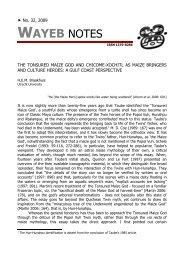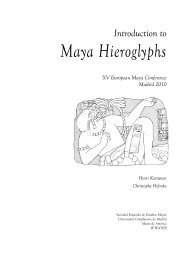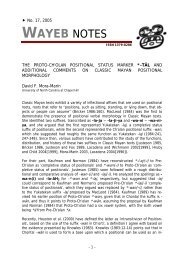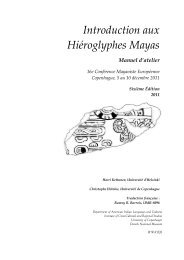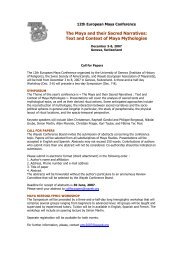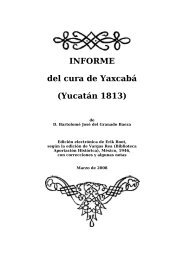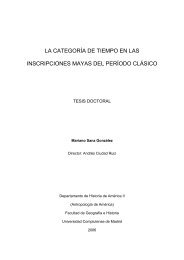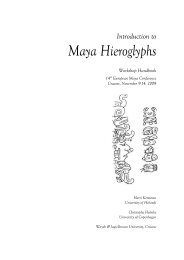Introduction to Maya Hieroglyphs - Wayeb
Introduction to Maya Hieroglyphs - Wayeb
Introduction to Maya Hieroglyphs - Wayeb
You also want an ePaper? Increase the reach of your titles
YUMPU automatically turns print PDFs into web optimized ePapers that Google loves.
Kettunen & Helmke 2011<br />
Thematic Dictionary: Verbs<br />
A THEMATIC CLASSIC MAYA – ENGLISH DICTIONARY<br />
VERBS<br />
Root/stem: Transliteration 80 : Transcription 81 : GC 82 : Translation 83 :<br />
ah-<br />
a-ha-la<br />
a-ha-li<br />
ah-al<br />
ah-aal<br />
iv<br />
<strong>to</strong> create, awaken<br />
ahk’- / ahk’u<br />
ya-k’a-wa<br />
ya-AK’-wa<br />
ya-k’u-tu-u<br />
y-a[h]k’-aw<br />
y-a[h]k’-[a]w<br />
y-a[h]k’u-tu’<br />
tv<br />
<strong>to</strong> give. Note the yahk’utu’<br />
example, which renders a<br />
noun for “gift”.<br />
ahk’t-<br />
a[AK’]-ta-ja<br />
AK’-ta-ja<br />
AK-ta-ji<br />
a-AK’-ta<br />
AK’-ta<br />
i-AK’-TAJ-ja<br />
AK’-TAJ<br />
a[h]k’t-aj<br />
a[h]k’t-aj<br />
a[h]k’t-aaj<br />
a[h]k’t-a[j]<br />
a[h]k’t-a[j]<br />
i-a[h]k’t-aj<br />
a[h]k’t-aj<br />
ivd<br />
<strong>to</strong> dance. Derived from the<br />
noun ahk’Vt (ahk’ot? /<br />
ahk’ut?) for “dance”, in<br />
which the (internal) vowel<br />
is syncopated in the<br />
verbalized form.<br />
ak- ya-ka-ta-ji y-ak-t-aaj * <strong>to</strong> leave, abdicate<br />
al-<br />
ya-la-ja<br />
ya-la-ji<br />
ya-la-ji-ya<br />
ya-la-[ji]ya<br />
y-al-aj<br />
y-al-aaj<br />
y-al-j-iiy<br />
y-al-j-iiy<br />
tv<br />
<strong>to</strong> say<br />
a’n-<br />
a-nu<br />
AN-nu<br />
a-AN-na<br />
a-AN<br />
AN<br />
a’n<br />
a’n<br />
a[’]n<br />
a[’]n<br />
a[’]n<br />
iv<br />
<strong>to</strong> be, exist – used as part of<br />
deity impersonation<br />
expressions<br />
ahn- a-ni a[h]n-i iv <strong>to</strong> run, walk<br />
at-<br />
ya-ti-ji<br />
ya-ta-ji<br />
ya-AT-ji<br />
y-at-ij<br />
y-at-[i]j / -aaj<br />
y-at-[i]j<br />
tvd<br />
<strong>to</strong> bathe<br />
bak-<br />
BAK-na-ja<br />
BAK-wa-ja<br />
u-BAK-wa<br />
ba[a]k-n-aj<br />
ba[a]k-w-aj<br />
u-bak-[a]w<br />
tv<br />
<strong>to</strong> make captive<br />
bal- / bahl-<br />
ba-la-ja<br />
u-ba-la-wa<br />
ba-la-ma<br />
BALAM-ma<br />
bal-aj<br />
u-bal-aw<br />
ba[h]l-am<br />
ba[h]l-am<br />
tv<br />
<strong>to</strong> hide, cover<br />
80<br />
This is a broad transliteration that excludes analyzed/interpreted sounds (vowel length, glottal s<strong>to</strong>ps, and /h/’s [preconsonantal velar fricatives])<br />
that are not inbuilt/inherent parts of hieroglyphs but were, conversely, indicated by harmony rules, grammatical inflection, and in the case of<br />
underspellings, provided by the native reader. Alternative spelling arrangements are based primarily on Boot 2009, Lacadena and Wichmann<br />
2004, Lacadena and Zender 2001, and Lacadena (personal communication, 2001-2006).<br />
81<br />
This is a narrow transcription including reconstructed sounds (marked by [square brackets]) based either on his<strong>to</strong>rical, internal, or paleographic<br />
evidence.<br />
82<br />
GC: Grammatical category; Abbreviations: verbs: iv: intransitive verb, ivd: intransitive verb (derived), pv: positional verb tv: transitive verb, tvd:<br />
transitive verb (derived); nouns and adjectives: adj: adjective, cn: composite noun, n: noun; other: adv: adverb, ag: agentive, cop: copula, dem:<br />
demonstrative pronoun, ip: independent pronoun, ncl: numeral classifier, num: numeral, part: particle, poss: possessive prefix, prep: preposition,<br />
pronA: pronominal absolutive suffix, pronE: pronominal ergative prefix.<br />
83<br />
This is really a gloss rather than translation (a gloss is a short general translation of a word or morpheme which does not take in<strong>to</strong> account the<br />
context in which it occurs). Nonetheless, when several well-attested meanings exist, these are sorted (in the order of numerical ascendancy) from<br />
the most literal <strong>to</strong> the most figurative. The latter do (<strong>to</strong> a certain degree) take in<strong>to</strong> consideration the various meanings that the contexts of<br />
wordscan potentially imbue them with.<br />
94/154



